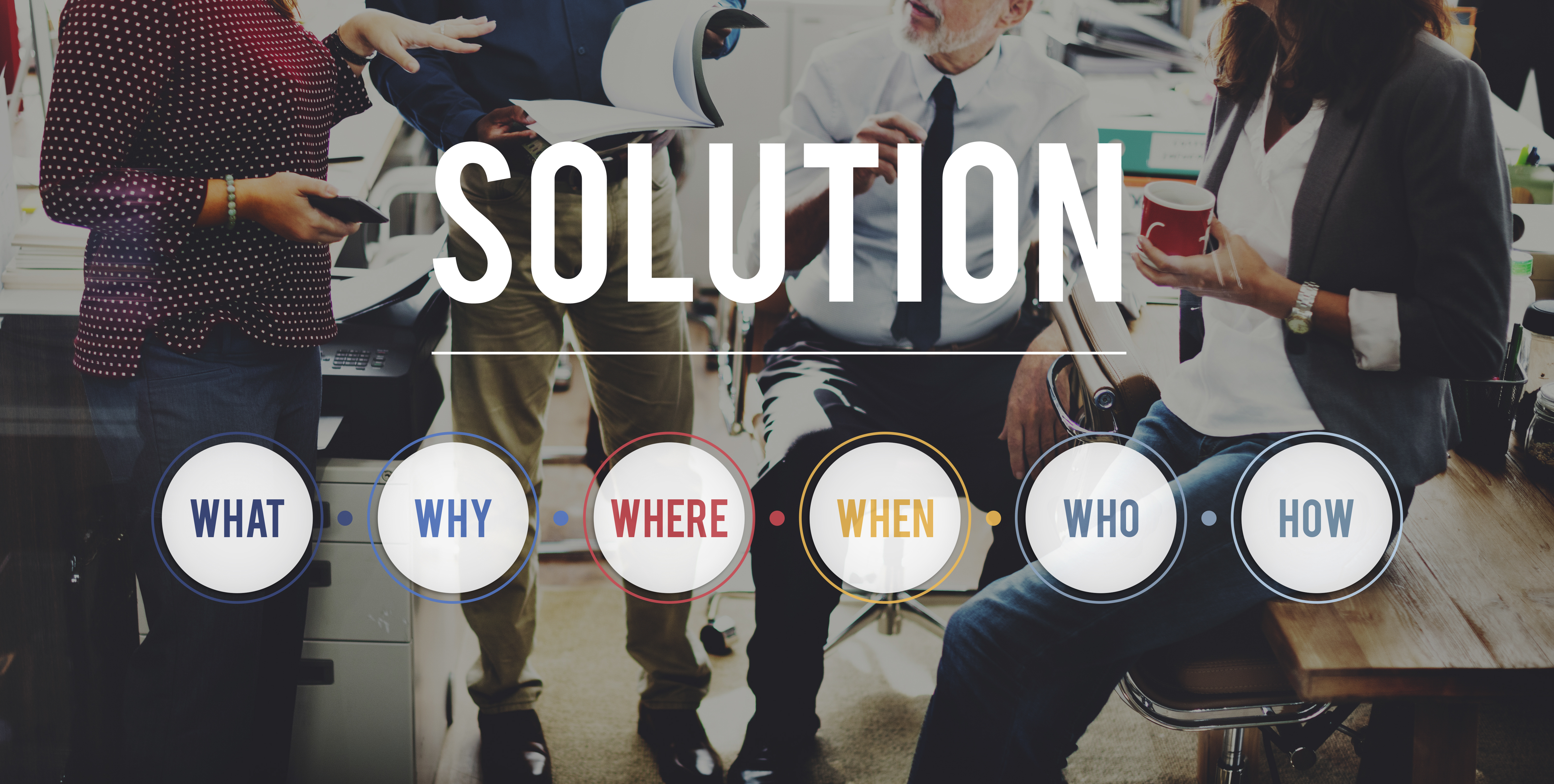Modul 6:Problem Solving
We have come to the “Problem Solving” competency main area, which is the last module of our course. Problems that sometimes manifest themselves in our daily life, sometimes unconsciously and sometimes clearly, are situations and events in which metacognitive mental processes that contain uncertainties that we need to produce solutions are effectively used. Problem solving competence within the scope of DigComp includes searching for solutions to the problems encountered during the use of digital technologies and producing solutions using digital technologies for the problem situations encountered. In this context, solving technical problems, determining the technological needs that will lead to a solution in all problem situations, especially the situations caused by these problems, choosing the appropriate technological applications and / or devices for the problem situation, using digital technologies in a creative way and determining the digital competence gaps to be determined in all these processes. determines the scope of this main competence area. As reflected in this context, the “Problem Solving” area is a related competence area that also includes competences in the other 4 areas of the DigComp framework. In other words, you will often observe that problem solving competencies are used in the process in the other 4 main competence areas, and you will be able to determine that the competences of the other 4 main areas are used in this main competence area. We cannot consider any area of DigComp as independent competencies, but problem solving and safety competencies are cross-competencies that exist in all domains and manifest in all skills that reflect that domain’s competencies. In other words, proficiency areas from 1 to 3 are in a linear structure, while areas 4 and 5 are diagonal and are referenced within other areas. To explain a little more, it can be seen that although problem solving is a field on its own, all other competence fields include the elements of problem solving. In the first field, Information and Data Literacy, it is seen that the cognitive dimension of problem solving, the competence of “evaluating information”, exists. Likewise, it is seen that there are different elements of problem solving in the second and third areas (such as interaction, collaboration, content development, integration, reorganization, programming). The purpose of this comprehensive explanation is to make the importance of problem solving competence area to be seen and understood more clearly.
Since DigComp is the last module of the Competence framework, we would like to give the following explanation without sharing the details of the subject. The DigComp digital competence framework is intended to explain digital competences rather than set strict rules and boundaries. It is a point noticed by each of us that digital competence has sensitive and controversial aspects, but this point is not included in DigComp. For example, an explanatory approach rather than a strictly prescriptive approach is observed in legal and ethical issues. In this context, for example, we cannot define an individual who downloads illegal programs with digital incompetence. The individual, who downloads the program illegally, is often aware of the licenses and rules he violates, that is, the consequences and responsibilities of his actions. Here, there is no problem in the knowledge dimension of the individual, but there is an inaccurate situation in the behavioral dimension. In this sense, within the framework of DigComp, competences have been mapped by suggesting the knowledge, skills and attitudes that will enable the behaviors to occur in the expected and desired way. After explaining this point in this way and emphasizing that the structure of the DigComp framework will be understood more clearly, we continue our module content.
 Problem solving is a multidimensional and widely used metacognitive competence that also manifests itself in other areas of DigComp. It includes high-level mental processes that require understanding of the problems, situations and issues encountered, their analysis, synthesis, induction and deduction. In these processes, the use of technological tools such as digital technologies, platforms, applications and devices is evaluated within the competence of this field. The DigComp framework describes problem solving, quoting the OECD report, “It is an individual’s capacity to employ metacognitive skills to understand and solve problem situations for which the solution method is not very clear. It includes the willingness to engage in such situations in order to realize the potential of a constructive and reflective active citizenship” (OECD, 2014). Technological solution, on the other hand, refers to an attempt to use technology (and/or engineering) to solve a problem. In this context, this competence area covers the solution of technical problems, the determination of digital resources and needs, the selection of the most appropriate technologies and tools for the needs and purposes, and the information-based decision-making process of these choices; using technologies to solve conceptual and factual problems with digital tools, to create knowledge, innovative processes and products; It includes individuals to identify and update their own proficiency gaps and to guide other individuals in a way that will eliminate proficiency gaps (Vuorikari, R. (2016). In the framework of DigComp 2.1., the main area of problem solving proficiency is to identify needs and problems in digital environments, to identify conceptual problems and problem situations. It is defined as solving problems, using processes and products with an innovative approach, and being aware of developments in digital technologies (EU Commission, 2019). is differentiated.
Problem solving is a multidimensional and widely used metacognitive competence that also manifests itself in other areas of DigComp. It includes high-level mental processes that require understanding of the problems, situations and issues encountered, their analysis, synthesis, induction and deduction. In these processes, the use of technological tools such as digital technologies, platforms, applications and devices is evaluated within the competence of this field. The DigComp framework describes problem solving, quoting the OECD report, “It is an individual’s capacity to employ metacognitive skills to understand and solve problem situations for which the solution method is not very clear. It includes the willingness to engage in such situations in order to realize the potential of a constructive and reflective active citizenship” (OECD, 2014). Technological solution, on the other hand, refers to an attempt to use technology (and/or engineering) to solve a problem. In this context, this competence area covers the solution of technical problems, the determination of digital resources and needs, the selection of the most appropriate technologies and tools for the needs and purposes, and the information-based decision-making process of these choices; using technologies to solve conceptual and factual problems with digital tools, to create knowledge, innovative processes and products; It includes individuals to identify and update their own proficiency gaps and to guide other individuals in a way that will eliminate proficiency gaps (Vuorikari, R. (2016). In the framework of DigComp 2.1., the main area of problem solving proficiency is to identify needs and problems in digital environments, to identify conceptual problems and problem situations. It is defined as solving problems, using processes and products with an innovative approach, and being aware of developments in digital technologies (EU Commission, 2019). is differentiated.
Problem Solving Process (Hayes, 1989)
5.1 Solving technical problems
This sub-competence area covers the competencies of evaluation, selection and use, including identifying and evaluating needs, identifying digital tools that will provide their solution, and possible technological alternatives. In this context, digital environments and technologies can be accessed, adjusted and customized to meet personal needs. In this process, individuals choose the most appropriate technologies, knowing their limitations and advantages, as a result of the analysis of the problems they encounter in all their routine and non-routine studies. Individuals can evaluate the solutions they come up with as a result of these choices, follow new technological developments by making informed decisions, and easily understand their use. In addition, he can adapt the solutions he produces to different problem situations and guide others on these issues.
5.2 Identifying needs and technological responses
This sub-competence area covers the competencies of evaluation, selection and use, including identifying and evaluating needs, identifying digital tools that will provide their solution, and possible technological alternatives. In this context, digital environments and technologies can be accessed, adjusted and customized to meet personal needs. In this process, individuals choose the most appropriate technologies, knowing their limitations and advantages, as a result of the analysis of the problems they encounter in all their routine and non-routine studies. Individuals can evaluate the solutions they come up with as a result of these choices, follow new technological developments by making informed decisions, and easily understand their use. In addition, he can adapt the solutions he produces to different problem situations and guide others on these issues.
5.3 Creatively using digital technologies
This sub-competence includes the innovative use of digital tools and technologies to create knowledge to solve problems. In this context, cognitive and technical skills are used to understand and solve conceptual problems and problem situations in digital environments, to provide active participation and to come up with creative solutions in cooperation with other individuals. The individual in this competency area can express himself creatively by using digital technologies and environments, produce innovative knowledge and solutions as well as produce solutions to problems. In addition, individuals can benefit from all technological opportunities and opportunities, produce meaningful information and content by using these resources and alternatives, reflect themselves effectively using rich digital media formats, take individual decisions in all processes and take an active role in environments where they can cooperate with other individuals. . In all these processes, individuals who develop their own knowledge, skills and attitudes with a critical approach can produce useful information and solutions for the society.
5.4 Identifying digital competence gaps
This sub-competence area includes the individual’s understanding at what points and areas his/her own digital competence needs to be developed or updated, and from this point of view, being able to support the digital competence development of others. In this context, opportunities for self-development should be sought and the developments in digital technologies should be followed regularly, and these should be understood and used. In other words, determining the digital competency gaps, which are the key sub-areas of the problem-solving main competency, requires the individual to be aware of his own competencies, to evaluate whether these competencies provide a solution when faced with problems, and to develop himself, if the existing competencies do not carry the individual to a solution, based on this evaluation.
Discussion
Experience Sharing
We expect you to share your experiences regarding “Problem Solving” of the Digital Competence Framework. Do not forget that the transfer of experience is very important in terms of providing new ideas to your colleagues in the context of professional development.
Below,you can examine how a sub-digital competence is leveled at the problem-solving area.
Please watch the video of Duygu EFETÜRK on the “Problem Solving” aspect of eTwinning projects.
eTwinning Content Development Trainer
İstiklal Makzume Anadolu Lisesi
İskenderun Turkey
The DigComp Problem Solving and eTwinning Projects Context
2. Please do not forget to answer the quiz questions about the Module.
Resources
Hayes, J. R. (1989). The Complete Problem Solver (2. Press). Rouledge.
The European Commission’s science and knowledge service, (2019).
OECD, (2014). TALIS 2013 Results: In international Perspective on Teaching and Learning.
Vuorikari, R. (2016). DigComp 2.0: The Digital Competence Framework for Citizens. Update Phase 1: The Conceptual Reference Model. Luxembourg: Publications Office of the European Union.














